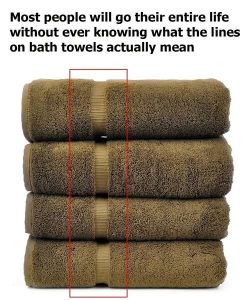For most of us, bath towels are a simple everyday essential—picked up, used, washed, and forgotten. But have you ever taken a closer look at the fine details woven into your towel? Those raised lines, patterns, or textured sections aren’t just for looks. In fact, they serve functional purposes that can impact the towel’s absorbency, durability, and even how well it holds up after repeated use.
Understanding these design choices not only enhances your appreciation of a well-made towel, but can also help you make smarter purchases when it’s time to restock your linen closet.
🔍 What Are the Lines on Bath Towels For?
At first glance, the lines or textured patterns that run along many bath towels may seem purely decorative. In reality, these lines are often the result of intentional weaving techniques designed to improve both form and function.
Towel manufacturers carefully engineer these lines to serve multiple purposes:
-
✅ Increase absorbency
-
✅ Enhance air flow for faster drying
-
✅ Provide structure and prevent fraying
-
✅ Offer a better tactile experience
-
✅ Guide folding or hanging
Let’s take a deeper look at how these lines work.
💧 Absorbency and Air Flow: How Lines Help You Dry Off Faster
One of the main goals of any good bath towel is to efficiently absorb water. The lines or ridges on the surface help achieve this by increasing the surface area of the fabric. More surface area means more contact with your skin—and more water being drawn in.
In addition, the slight variations in texture create micro-channels for air to circulate, allowing the towel to dry more quickly after use. This not only helps prevent musty odors but also improves hygiene by limiting the growth of mildew.
🧵 Reinforced Weaving: Strength in Structure
Many towels feature what are known as tread lines—raised sections that run parallel along the towel’s length. These are more than just texture—they serve as reinforced zones within the towel’s weave.
Over time, towels can stretch, fray, or lose their shape due to frequent washing. Tread lines support the towel’s structure, helping it maintain its original form and plushness even after dozens of laundry cycles. In essence, they act like built-in reinforcements that add stability and strength to the fabric.
📐 Aesthetic and Practical Cues
Interestingly, these lines can also serve as visual guides for folding and hanging. A towel with a clear pattern or border is easier to fold neatly, and some people even use the lines to fold towels uniformly for organized storage. In hospitality settings, like hotels or spas, this design feature ensures a consistent and tidy appearance when towels are stacked or displayed.
🛍️ What to Look For When Buying Towels
Now that you know these lines are more than just design flourishes, here are a few tips when shopping for new towels:
-
Feel the texture: A mix of soft pile and subtle tread lines usually indicates a thoughtful balance between comfort and structure.
-
Check the weave: Towels with visible reinforced bands tend to hold up better over time.
-
Look for symmetry: Even spacing of lines is often a sign of quality craftsmanship.
-
Test absorbency: The more texture and depth in the towel, the more effective it usually is at drying.
🧠 Final Thoughts: Hidden Engineering in Everyday Life
Next time you pick up a towel, take a moment to appreciate the thought that went into its design. Those lines aren’t just a pattern—they’re a product of engineering, testing, and textile tradition. They help you dry faster, stay warmer, and keep your towels looking and feeling great for years to come.
Who knew something as ordinary as a towel could hold such smart, subtle design?







